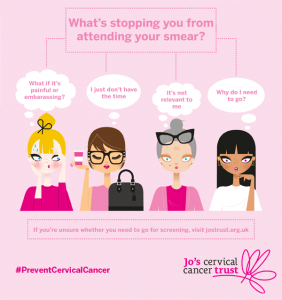Prevalence of beliefs about actual and mythical causes of cancer
By Jo Waller, on 26 April 2018
Lion Shahab, Jennifer A. McGowan, Jo Waller, Samuel G. Smith
Approximately one third to one half of cancer diagnoses are preventable by changes to lifestyle behaviours. In Europe, at least 1.1 million cancer cases per year could be prevented if people had healthier lifestyles. According to the latest (4th) European Code Against Cancer (ECAC), established cancer risk factors include active and passive smoking, alcohol consumption, being overweight or obese, being physically inactive, have a poor diet, being exposed to ultraviolet radiation (e.g. from the sun), and infection with human papillomavirus (HPV). However, many other unverified (‘mythical’) causes of cancer appear in tabloids and on social media. Recognising the difference between the real and the ‘mythical’ cancer causes can be difficult. Conflicting messages can make it harder for people who are trying to reduce their cancer risk to place their efforts into effective activities.
In a study published in the European Journal of Cancer, we report findings from the 2016 Attitudes and Beliefs About Cancer-UK Survey of 1,330 UK participants. The survey explored the public’s beliefs about actual cancer causes (smoking, alcohol consumption, low physical activity, low fruit and vegetable consumption, being overweight) and mythical causes of cancer. Awareness of actual causes of cancer was low, with participants on average on being able to identify half of the causes of cancer. More than a third (40%) of adults did not know that being overweight was associated with an increased cancer risk and the same number did not recognise sunburn as a cancer risk. Almost three in four adults (71%) did not know that HPV is associated with cancer. Being able to identify correct causes of cancer was related to the likelihood of participants not smoking, and eating five or more fruit and vegetables a day.
Participants could, on average, only identify 36% of mythical causes of cancer as incorrect. Of these, adults were most likely to believe that stress (43%), food additives (42%) and electromagnetic frequencies (35%) caused cancer. A quarter (26%) of participants believed that mobile phones could cause cancer. Interestingly, adults who endorsed the actual causes of cancer were also more likely to also believe in the mythical causes, suggesting a great level of confusion between the two.
If people are to make informed decisions about their lifestyle they need an accurate understanding of cancer risk factors. Our survey shows that there is a large degree of confusion among the general public regarding those risks. It seems that the numbers of people who believe in the unfounded causes of cancer has increased over the last decade. This could be linked to the way people now access information and the rise of so-called “fake news”. Looking for information from reputable websites like NHS Choices and Cancer Research UK is a good way to avoid this. Cancer Research UK even has a page presenting evidence to debunk some the myths, which could be a useful resource for people who are understandably confused.
 Close
Close


